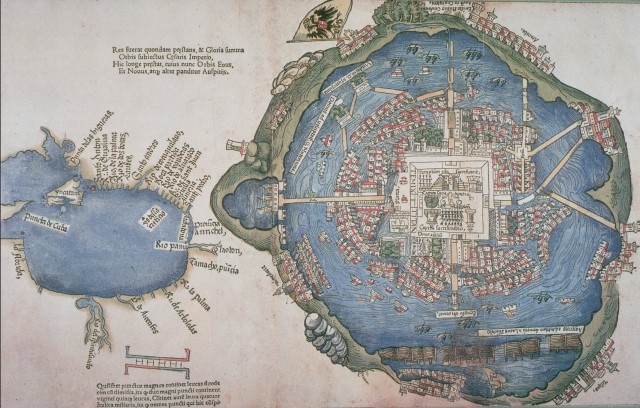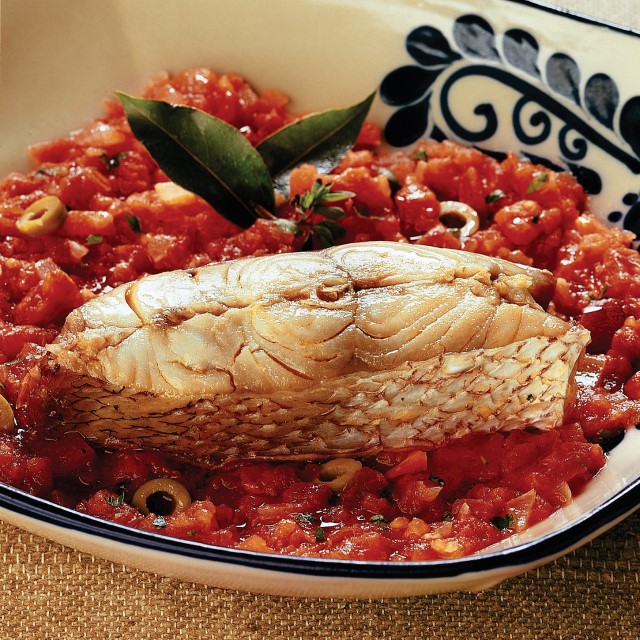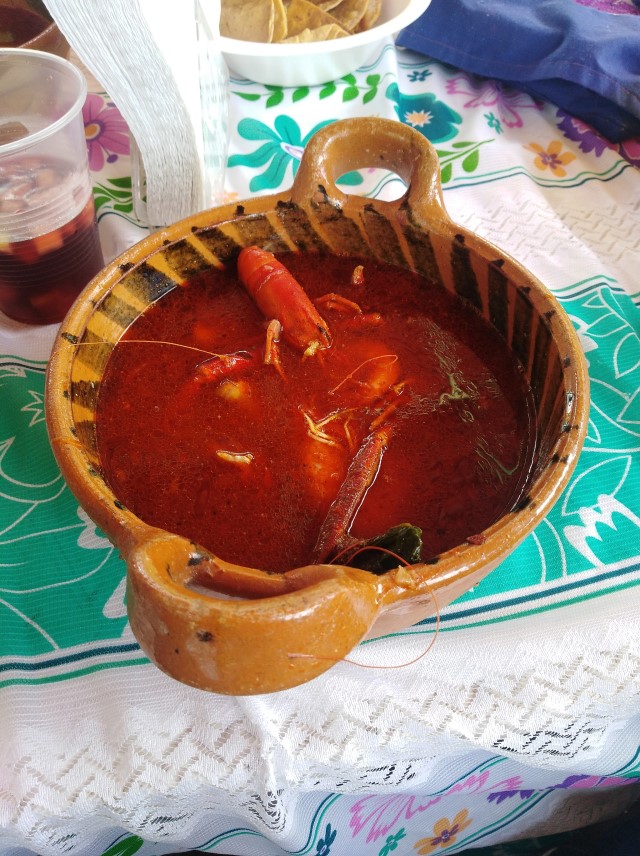“The True Story of the Conquest of New Spain” was authored by Bernal Díaz del Castillo, a Spanish soldier in the conquistadors’ army. He finished writing his book in 1568 and died 16 years later in 1584 in what is today Guatemala. However, his book was published in Spain in 1632, 48 years after his death. Since he didn’t proofread the final version of his work, it was most likely subject to alterations and possibly led to dispersing wrong facts and conclusions. In this work, Díaz del Castillo describes vividly, among other things, the dishes Moctezuma II had at his disposal on a daily basis. He talks about 30 different dishes that were prepared daily in an amount of 300 servings. The food was presented over white table clothes with beautiful women doing the table service furnishing constantly water, tortillas and clean towels. This display of sophistication and complexity in the cooking and serving was unexpected and astonishing to the Spaniards.

Map of Tenochtitlan in 1524 AD.
The fastuosity of these banquets undoubtedly led to many legends. A popular one is that fresh fish was brought to Moctezuma II’s table from the Gulf of Mexico to Tenochtitlan some 250 miles away. This feat was accomplished through a team of relay runners called painanis. Seafood was not the only thing these runners transported; exotic fruits and vegetables were also moved through this method. Messages—drawings made on cotton paper—were also very important items to transport and deliver. It’s said that these runners were used to announce to Moctezuma II that the Spaniards had arrived.
Five hundred years after these events, a relay foot race was organized from the Port of Veracruz to Teotihuacan, in the outskirts of Mexico City. It was some 20 miles less than the original distance to avoid the hassle of entering the capital’s downtown. Even though the original route was adjusted for logistical reasons and was a bit shorter, it took the winning team 34 hours to arrive at the finish line. With 1,200 participants, the event proved to be a success, but it also proved that the Moctezuma II legend remains that: only a legend. It is impossible to transport fresh seafood from the Port of Veracruz to Mexico City on foot without refrigeration and avoiding spoilage. And considering the shaking involved in running for two days, this most definitely had ruined the texture of the fish. While Moctezuma II definitely ate fish, it came from around his own city: Tenochtitlan, which was built in the middle of a lake…
With the presence of immigrants from Spain—and their African slaves—and later France, the Middle East, China, among other countries, Mexican gastronomy expanded significantly by the influence of imported ingredients, recipes and techniques. The seafood arena was no exception. The variety of seafood found in Mexico resulted in an incredible new assortment of dishes. And we must not forget that seafood is an impressive versatile family of foods that can be boiled, fried, grilled, baked, roasted, smoked, or eaten raw! As you can see, the Mexican seafood equation has many variables, all contributing to the immense variety of dishes we have today.
In the 1500’s the Port of Veracruz became the port of entry of European culture to Mexico. Gastronomy was only one manifestation of it—a very important one—and the books on Veracruz cuisine are there to prove it. There is a pattern in their recipes where imported ingredients such as olive oil, olives, capers, oregano, cloves, and cinnamon, among others, appear repeatedly.
During my days as a student in France, I made an effort to try at least one dish representative from every region I visited. In the Côte d’Azur, some friends and I went to a decent restaurant—no budget for fancy places—to try the famous bouillabaisse. To my shocking surprise, it tasted the same as my mother’s Sopa de Pescado a la Veracruzana! I was a bit disillusioned, spending precious travel money on something I was very familiar with! I guess I just had paid to learn about the roots of the food I had at home. La bouillabaisse had traveled from Europe to Mexico many years before I could travel to Europe. Many “Mexican” dishes thus were born abroad, many are the result of the marriage of foreign ingredients while others are autochthonous. And the famous Sopa de Pescado a la Veracruzana, is just one more debt we have with France.

Huachinango a la Veracruzana
Among the most representative dishes from Veracruz, we mention Huachinango a la Veracruzana, a pan cooked red snapper with a complex sauce made with tomatoes, olives, capers and chile güero; Arroz a la Tumbada, a rice—brought to America by Christopher Columbus—dish with a choice of shrimp, squid, crab and clams; Chilpachole de Jaiba, a thick crab broth prepared with chile chilpaya—cousin of chile piquín—olive oil, cloves and cinnamon; Vuelve a la vida, literally “back to life” is a seafood cocktail made with shrimp, squid, oysters, crab, and seashell served on a sea urchin stock, dressed with olive oil—said to be the best remedy for hangover.

Chilpachole de Mariscos (Credit: wikimedia.org)
As proud as they are of their cuisine, people from Veracruz should not forget that it represents unmistakably the fusion of two cultures, perhaps more because some of those ingredients arrived in Europe from Africa, the Middle East, and Asia before the Spaniards embarked to America. Veracruz, however, was the place of marriage of those ingredients, a marriage that has lasted more than 500 years, and the birthplace of a cuisine in La Nueva España: the Mexican seafood cuisine.
Recipes for The Birth of Mexican Seafood
Sopa de Pescado a la Veracruzana
A soup rich in flavor, it’s a favorite for “días de norte” or bad weather days produced by the northern winds and rain in the State of Veracruz.
Ingredients
- 1 lb catch-of-the-day in chunks
- 2 tomatoes, diced
- ½ onion, finely chopped
- 2 to 4 Chiles Gueros, sliced
- 2 garlic cloves, minced
- 2 garrots, diced
- 1 potato, diced
- 1 tbsp capers
- 2 tbsp olives, chopped
- olive oil
- 1 qt fish stock
- A pinch of fine herbs
- Salt and pepper to taste
Instructions
- In a stock pot, sauteé with the olive oil, the tomatoes, onions, garlic and chiles. Add the fish chunks and sautée them until they change color, remove them, and reserve.
- Add the carrots, potatoes, capers, olives and the stock, boil for 10 minutes. Add the fish and boil for another 15 minutes. Add the salt, pepper and herbs, and boil for the last 5 minutes. Enjoy!
Yield: Four servings
Heat level: Mild
Chilpachole de Mariscos
The classic recipe calls for crab but it can be prepared with any crustaceans on hand. This dish can be an appetizer, first course, or main course depending on the size of the serving. It can be spicy or not, making it a versatile option for entertaining.
Ingredients
- 1 lb tomatoes, diced
- ½ onion, chopped
- 2 garlic cloves, minced
- 2 to 4 chipotles, chopped
- olive oil
- 1 qt fish stock
- 1 lb of your favorite mix of meaty crustaceans
- 1 small stick of cinnamon
- 1 sprig of epazote
- cornmeal as thickening agent
- Salt to taste
Instructions
- In a stock pot, sautée the tomatoes, onions, garlic and chiles with the olive oil. Add the crustaceans and sautée them until they change color, remove them, and reserve.
- Add the stock, and boil for 5 minutes. Add the crustaceans and boil for 10 more minutes. Add the cinnamon, epazote, cornmeal and salt, and boil for 5 to 10 more minutes. Remove the cinnamon stick and enjoy!
Yield: four servings
Heat level: medium
Latest posts by José C. Marmolejo (see all)
- Unconventional Seafood Salsas - 04/25/2022
- Cocineras Tradicionales: The Traditional Cooks of Mexico - 04/01/2022
- Carnitas Calientes - 03/11/2022








